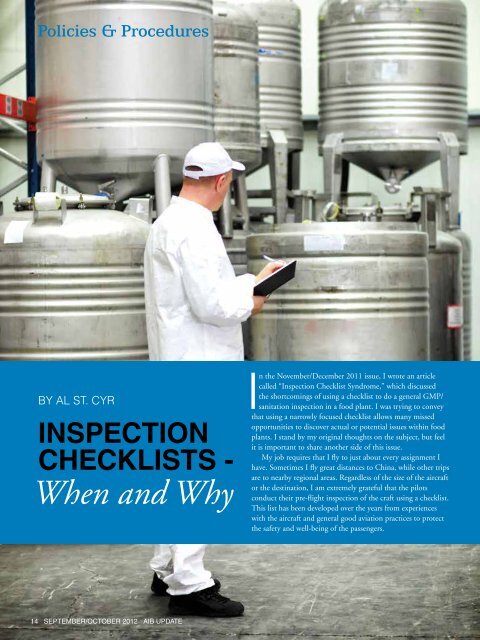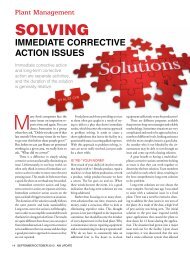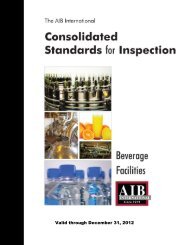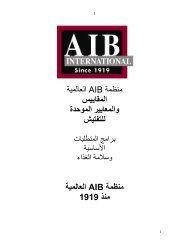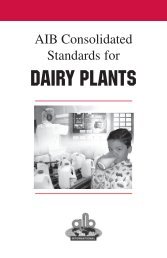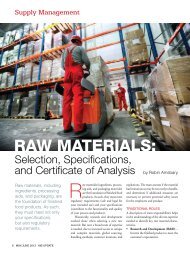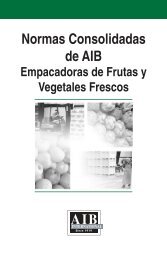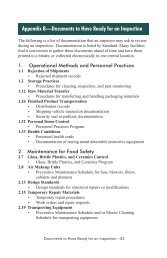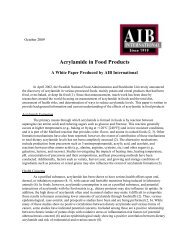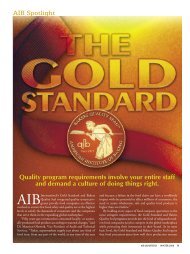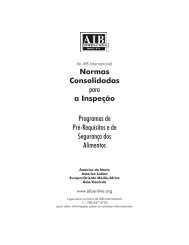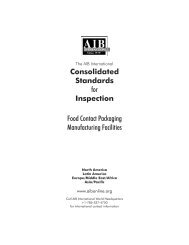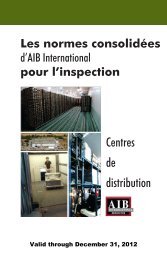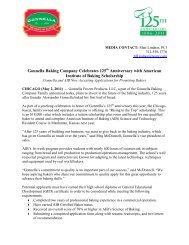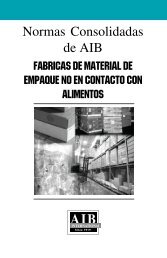Inspection Checklists - AIB International, Inc.
Inspection Checklists - AIB International, Inc.
Inspection Checklists - AIB International, Inc.
You also want an ePaper? Increase the reach of your titles
YUMPU automatically turns print PDFs into web optimized ePapers that Google loves.
Policies & Procedures<br />
by Al St. Cyr<br />
<strong>Inspection</strong><br />
<strong>Checklists</strong> -<br />
When and Why<br />
In the November/December 2011 issue, I wrote an article<br />
called “<strong>Inspection</strong> Checklist Syndrome,” which discussed<br />
the shortcomings of using a checklist to do a general GMP/<br />
sanitation inspection in a food plant. I was trying to convey<br />
that using a narrowly focused checklist allows many missed<br />
opportunities to discover actual or potential issues within food<br />
plants. I stand by my original thoughts on the subject, but feel<br />
it is important to share another side of this issue.<br />
My job requires that I fly to just about every assignment I<br />
have. Sometimes I fly great distances to China, while other trips<br />
are to nearby regional areas. Regardless of the size of the aircraft<br />
or the destination, I am extremely grateful that the pilots<br />
conduct their pre-flight inspection of the craft using a checklist.<br />
This list has been developed over the years from experiences<br />
with the aircraft and general good aviation practices to protect<br />
the safety and well-being of the passengers.<br />
14 september/october 2012 <strong>AIB</strong> UPDATE
Policies & Procedures<br />
Does this system ever fail? Personally,<br />
I would rather not dwell on the rare occasions<br />
where it failed to detect an issue,<br />
but in those instances the pilot had confidence<br />
in the system’s ability to function<br />
before it started, otherwise the aircraft<br />
would not have passed inspection.<br />
This same principal needs to be applied<br />
in the food industry. Just like the<br />
importance of checking on critical functions<br />
and systems before a plane takes<br />
off, the same system should be in place<br />
when starting up a processing system.<br />
Who knows what could have happened<br />
from the time you left the equipment at<br />
the end of your shift until the time you<br />
returned to resume production. It has<br />
likely been through sanitation procedures,<br />
maintenance repairs, and idle time. That<br />
is a considerable amount of time outside<br />
of your direct control where something<br />
could have happened.<br />
A checklist that provides a specific focus<br />
on a piece of equipment or system is<br />
a valuable tool. It establishes the expectation<br />
and highlights the important things<br />
to look for to help prevent very costly<br />
incidents.<br />
Too often, underlying risks with food<br />
manufacturing systems are ignored until<br />
an event happens. This is unfortunate<br />
and short-sighted since there are enough<br />
reported incidents to thoroughly convince<br />
us of the benefit of inspecting our<br />
systems before turning them on.<br />
A pre-start-up list can include several<br />
other considerations besides sanitation<br />
and proper assembly. For example,<br />
you could include verification that the<br />
operational settings are correct from the<br />
start, instead of simply adjusting them as<br />
you go. This would likely save product,<br />
increase yield, and reduce issues with<br />
components down the line. Use a list to<br />
verify you have taken care of all of the<br />
important items that experience and<br />
history with the system have told you to<br />
check. If a problem develops, you will be<br />
starting from a known point and will save<br />
time finding a solution.<br />
the Pre-Start-up Checklist.<br />
Regardless of how simple or complex a<br />
system is, there is always a chance that<br />
something could go wrong. This is where<br />
a pre-startup checklist would be a significant<br />
benefit. Ask:<br />
• Have all product contact areas been<br />
properly cleaned?<br />
• Have all tools used for sanitation or<br />
maintenance been removed?<br />
• Is all equipment that was removed for<br />
cleaning put back in place and properly<br />
aligned?<br />
Everyone likely has a story about<br />
how they started up a system and a pipe<br />
connection wasn’t secured, a transfer<br />
sleeve was not reinstalled, or drains were<br />
left open to spill hundreds of gallons of<br />
material onto the floor and down the<br />
drain. The list of items to verify as correctly<br />
completed could be quite long or<br />
Experience tells<br />
me that it is the<br />
little things that<br />
often result in<br />
the biggest issues.<br />
short. Each plant will have to decide what<br />
is important for operation, and add the<br />
items to its list.<br />
What could be more important than<br />
verifying that an allergen cleaning has<br />
been properly conducted on a system?<br />
There is always a chance that one element<br />
of the system was overlooked or not<br />
properly cleaned to remove the risks for<br />
allergen contamination.<br />
This is particularly true when you<br />
are pressured for time and rushed to get<br />
production up as fast as possible. Using<br />
a checklist to verify that everything is<br />
ready to go when the program demands it<br />
be used, affords you a level of safety and<br />
consumer protection. This should be a<br />
non-negotiable issue.<br />
Maintenance often receives quite a<br />
bit of heat when things go wrong in the<br />
production area after systems have been<br />
worked on. Things get overlooked, perhaps<br />
equipment was not tightened as it<br />
should be or someone soiled a food contact<br />
surface without realizing it. Assuming<br />
that others will take care of items, rather<br />
than doing them ourselves, can lead to<br />
failure. A post-maintenance checklist can<br />
assist in avoiding many of these issues.<br />
Was the system restored to working condition?<br />
Did we drain a component that<br />
needs to be refilled before production can<br />
start? How many parts are left over after a<br />
piece of equipment was disassembled? Is<br />
everything put away properly?<br />
Little Things: Biggest Issues.<br />
It might seem that some of these simple<br />
issues don’t need to be included on a list,<br />
but experience tells me that it is the little<br />
things that often result in the biggest<br />
issues. The inevitable question is asked<br />
in nearly every event, “Why wasn’t that<br />
taken care of before we started?” And in<br />
almost every instance, the answer is, “I<br />
forgot,” “I thought someone else took<br />
care of that,” or “I didn’t check it.”<br />
It is extremely important that prestart-up<br />
checklists become a mandatory<br />
element of your programs. The biggest<br />
issue to guard against is complacency.<br />
People tend to get to a point where they<br />
think they have the checkpoints memorized<br />
and stop using the list. They reason<br />
that they will just fill it out later when<br />
they have more time. However, as with<br />
all other required documentation, from<br />
lot number recording to metal detector<br />
verification logs, these documents must<br />
be taken seriously.<br />
I continue to believe that checklists<br />
used for a general inspection of a food<br />
plant limit the ability to do as thorough<br />
and detailed job as you could, because<br />
they restrict you to only looking for<br />
specific issues. However, on the other<br />
hand, a checklist developed for a specific<br />
function to verify that critical issues have<br />
been taken care of before equipment is<br />
placed into use is indispensable.<br />
Just as pilots understand their responsibility<br />
to get passengers to their final<br />
destination, the food industry has to have<br />
the same attitude toward protecting our<br />
customers from harm and ensuring our<br />
systems are ready to fly. <strong>AIB</strong><br />
The author is Head of Food Safety Education,<br />
<strong>AIB</strong> <strong>International</strong>.<br />
<strong>AIB</strong> UPDATE september/october 2012 15
NEW <strong>AIB</strong>’s<br />
Food Safety<br />
360 o<br />
Intensified Food Safety Evaluation and Education<br />
<strong>AIB</strong> has been a leader in providing independent food safety inspection, audit, and educational services<br />
to industry for over 60 years.<br />
In recent years, with the rise of the Global Food Safety Initiative (GFSI) audit schemes, and with the<br />
passage of the 2011 Food Safety Modernization Act, <strong>AIB</strong>’s distinctive ability to provide thorough facility<br />
inspections has become more important than ever before. Many have chosen to continue with the full<br />
<strong>AIB</strong> GMP <strong>Inspection</strong>, often in conjunction with a GFSI audit.<br />
However, others have requested that we develop an evaluative product that will be additive to their food<br />
safety program and not duplicate audit elements found elsewhere.<br />
FS•360 is derived from the core elements of the<br />
<strong>AIB</strong> Consolidated Standards for <strong>Inspection</strong>.<br />
It is guided by two critical sections of the Food,<br />
Drug and Cosmetic Act of 1938:<br />
• Section 402 (a)(3)<br />
• Section 402 (a)(4)<br />
SCOPE AND CHARACTERISTICS<br />
FS 360<br />
The scope of the FS•360 evaluation within<br />
a facility will be determined by the client<br />
through prior discussion with <strong>AIB</strong>. The visit<br />
typically will be announced.<br />
FS•360 is intended to be consultative and<br />
educational in nature. It is recommended a<br />
facility be down, or at least partially down.<br />
After an <strong>AIB</strong> <strong>International</strong> FS•360 has been<br />
completed no score or laudatory terminology<br />
will be given.<br />
Report-writing will be kept to a minimum, unless<br />
otherwise requested by the client. Typically<br />
records will not be reviewed. The intent<br />
is to maximize the floor time spent by the <strong>AIB</strong><br />
expert during his/her visit.<br />
Contact us today!<br />
800-633-5137 or<br />
jlazaro@aibonline.org<br />
FS•360 can be used in a free-standing<br />
manner or complementary to other audits,<br />
including the GFSI schemes or extending the<br />
scope of the <strong>AIB</strong> Consolidated Standards<br />
to really challenge your GMPs. Its entire<br />
focus is a detailed probe of facility<br />
on-floor food safety practices.<br />
After all, this is where the<br />
food is produced.<br />
www.aibonline.org


